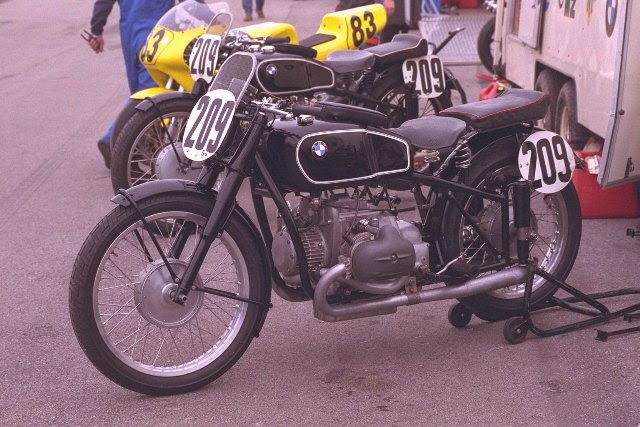The
International Six Days Trial (ISDT) is the oldest 'off road' motorcycle event on the
FIM Calendar.
The ISDT was first held in 1913 at Carlisle, England. The event has occurred annually since then, apart from interruptions due to World War I and World War II, at various locations throughout the world. The ISDT is a true test of machine, rider, skill, and reliability.
Up until 1973 the contest was always held in Europe. In 1973 the event travelled to the United States for its first non-European venue. Since then the race has been outside of Europe more frequently: twice in Australia (1992 and 1998), once more in the USA (1994), Brazil (2003), New Zealand in 2006 and Chile in 2007. In 1980 the name was changed to 'International Six Days Enduro' (ISDE).
The event has attracted national teams from as many as 32 different countries in recent years. Over its long history the rules and conditions have changed to keep in step with the developments in the sport, but it remains a supreme test of rider and machine. Over the six days and upwards of 1250 miles a rider must contend with strict rules about time allowances and restrictions on mechanical replacements, as well as carrying out his or her own track-side repairs.
Usually referred to as the 'Olympics of Motorcycling' with trophies for best six-rider national, four-rider junior national, three-rider women's national, three-rider club and three-rider manufacturing teams. Gold, silver and bronze medals are awarded on an individual level.
The medals are typically awarded based on percentage of finishers, or relative to the best individual performance in the event within one of the three displacement classes.
The ISDE can attract entries of more than 500 riders, together with thousands of support crew and spectators. This has a major impact on tourist income for the venue in which it is based each year.
For a list of host, venue and winners of the ISDT from 1949 through 1980, click here:
ISDT
 |
| Herbert Schek, Gold Medal winner on board a BMW (great jersey!) |
BMW involvement in the ISDT dates back to the infancy of the marque as an independent motorcycle manufacturer.
Below is an example of a BMW works prepared R67 ISDT. This particular bike, reportedly raced by Georg "Schorsch" Meier, was previously in the collection of Willy Neutkens. Neutkens was a long time BMW dealer and collector in the Netherlands. After his recent passing, the family put his collection up for auction, which was held in Munich, in conjunction with BMW Classic.
The bike was purchased by BMW for their collection, and now resides in the BMW Museum across from street from the BMW Welt complex.
 |
| Notice the front number plate is on a pivot. This serves two purposes, the plastic plate protects the glass of the front headlight during the day, and can be flipped up for riding at night. |
 |
| Two into one exhaust is for more than just good looks. The higher location on the bike affords one the capability of crossing water hazards without filling the tailpipes! What looks to be a second carburetor on the right side is a spare slide attached to the spare throttle cable. In the event of a slide or cable failure, the pilot could easily swap. |
 |
| Knobby tires front and rear. Also notice that a bar is welded to the front and rear axles to afford quick wheel removal in the event of a flat. |
 |
| Nice closeup of the Magura quick throttle and Magura racing levers or "rennhebel". Also note the spare cables strapped the throttle cables in the event a trail side repair is necessary. |
 |
| Detail of the "crash bars" and the oil pan guard. |
 |
| Rennbrotchen or "racing bread loaf". Note this one differs from the road racing version as a side zipper allows one to stash tools and spares. |
 |
| Cross drilling the seat frame must have saved at least a few grams of weight! |
 |
| Notice the rare fender with a subtle flare at the bottom which is a hybrid design between the R68 version and the larger flared street version found on the civilian R67. |
Compare and contrast the differences from the mid 50's version of a works BMW ISDT racer with the 1980 ISDT winner pictured below.
See below for some pictures of an R68 ISDT replica in a private collection here in the US. Luckily for those interested in recreating one of these off-road machines, many of the parts such as the special rear fender, 2 into 1 exhaust, oil pan guard, etc are available, albeit at a hefty price.
 |
| Hoske ventilated front "bremseplatte" and Hoske full width "nabe". Both very rare and very expensive. The keen observer will also note the deep sump on this particular bike. |
 |
| With the 2 into 1 exhaust crossing above the right side cylinder and head, one must use a special clip to keep from melting the right side throttle cable and fuel line! |
 |
| Hoske full width rear hub. The front and rear hubs are different. Unlike most BMW hubs which are interchangeable front and rear, the front Hoske hub has no drive spines, to save weight. The shoes and pads are of couse wider, providing extra stopping power. |













































